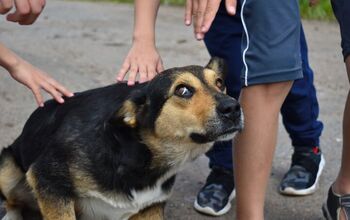What is Canine Blastomycosis?

Dogs have a habit of getting into everything and they often do not realize that the things they are getting into could possibly make them sick. If you frequently take your dog for walks in the woods, he may be at risk for exposure to a type of fungal infection called canine blastomycosis. Keep reading to learn more about what this disease is and how it is treated.
Related: Leptospirosis in Dogs
Understanding Canine Blastomycosis
Canine blastomycosis is a type of yeast-like fungal infection caused by the fungus Blastomyces dermatitidis. This fungus is most commonly found in decaying wood and soil, so dogs that spend a lot of time in the woods or in other damp conditions near riverbanks, lakes, and swamps have the highest risk for coming into contact with the fungus.
In fact, studies have shown that most of the dogs affected by this disease live within 400 meters of a body of water. This infection can affect all kinds of dogs, but it seems to be more common in male dogs than in female dogs. Some of the most common symptoms of canine blastomycosis include the following:
- Fever
- Loss of appetite
- Unexplained weight loss
- Discharge from the eye
- Eye inflammation
- Difficulty breathing
- Skin lesions
A dog generally contracts canine blastomycosis by breathing in the airborne fungal spores after soil contaminated with the fungus has been disturbed. This can happen when the dog is digging in contaminated soil or simply by running through it. It is also possible for the spore to enter the dog’s body through the skin.
Related: What Should You Know About Pythiosis in Dogs?
Diagnosis and Treatment for Blastomycosis
Unfortunately, the symptoms of canine blastomycosis overlap with a variety of other conditions so it is not uncommon for this infection to be misdiagnosed as something else. This condition is often mistaken for cancer or for bacterial lung infections – treatments for these diseases are different and the misdiagnosis could mean that the infection is allowed to spread for weeks or months before being properly diagnosed and treated.
Diagnosis of canine blastomycosis generally requires a physical exam and a biopsy of cells from the lymph nodes and tissue from the lungs. In most cases, treatment can be administered at home in the form of antifungal medications which should be given for a minimum of 60 days, or for at least one month after symptoms have subsided.
In severe cases where medical treatment is not sufficient, surgery may be performed to remove damaged portions of an abscessed lobe in the lungs. Fortunately, this disease generally doesn’t spread from one animal to another or from dogs to humans. It is possible, however, for humans to be exposed to the fungal spores on their own through inhalation into the lungs or through open wounds.
As long as you catch canine blastomycosis early and seek treatment, the prognosis for this disease is generally good. Just be sure to consult your veterinarian and complete the entire course of antifungal treatment to ensure that the infection is completely eradicated from your dog’s system.

Kate Barrington is the loving owner of two cats (Bagel and Munchkin) and a noisy herd of guinea pigs. Having grown up with golden retrievers, Kate has a great deal of experience with dogs but labels herself a lover of all pets. Having received a Bachelor's degree in English, Kate has combined her love for pets and her passion for writing to create her own freelance writing business, specializing in the pet niche.
More by Kate Barrington























